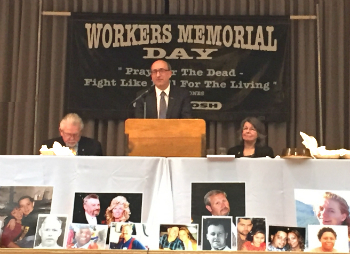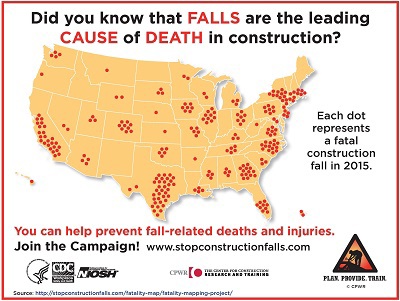 OSHA, the National Institute for Occupational Safety and Health and the Center for Construction Research and Training have developed a new series of infographics that illustrates the importance of preventing falls in construction. These infographics, available in both English and Spanish, raise awareness on fall hazards and resources for preventing them – including a ladder safety app. The infographics can be downloaded as PDFs or JPEGs for use in social media, presentations and print materials from stopconstructionfalls.com.
OSHA, the National Institute for Occupational Safety and Health and the Center for Construction Research and Training have developed a new series of infographics that illustrates the importance of preventing falls in construction. These infographics, available in both English and Spanish, raise awareness on fall hazards and resources for preventing them – including a ladder safety app. The infographics can be downloaded as PDFs or JPEGs for use in social media, presentations and print materials from stopconstructionfalls.com.
Wednesday, May 18, 2016
Preventing construction falls: infographics available
 OSHA, the National Institute for Occupational Safety and Health and the Center for Construction Research and Training have developed a new series of infographics that illustrates the importance of preventing falls in construction. These infographics, available in both English and Spanish, raise awareness on fall hazards and resources for preventing them – including a ladder safety app. The infographics can be downloaded as PDFs or JPEGs for use in social media, presentations and print materials from stopconstructionfalls.com.
OSHA, the National Institute for Occupational Safety and Health and the Center for Construction Research and Training have developed a new series of infographics that illustrates the importance of preventing falls in construction. These infographics, available in both English and Spanish, raise awareness on fall hazards and resources for preventing them – including a ladder safety app. The infographics can be downloaded as PDFs or JPEGs for use in social media, presentations and print materials from stopconstructionfalls.com.
New fact sheets available on hazards related to scaffolds, marine terminals and confined spaces
Fall protection chapter added to OSHA Technical Manual
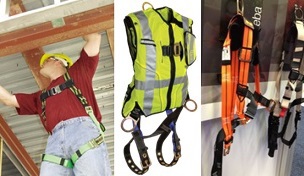 OSHA has published a new chapter in theOSHA Technical Manual. Chapter 4, Section V, "Fall Protection in Construction," provides OSHA inspectors with technical information critical in evaluating fall hazards and abatement methods in the construction industry. This chapter includes key information on fall prevention, hazard assessment, and detailed images on protection equipment.
OSHA has published a new chapter in theOSHA Technical Manual. Chapter 4, Section V, "Fall Protection in Construction," provides OSHA inspectors with technical information critical in evaluating fall hazards and abatement methods in the construction industry. This chapter includes key information on fall prevention, hazard assessment, and detailed images on protection equipment.
Because nearly half of all construction worker deaths are due to falls, OSHA is holding its third annual National Safety Stand-Down May 2-6.
NIOSH releases study on work-related hearing loss
 The National Institute for Occupational Safety and Health released a study last month in its Morbidity and Mortality Weekly Report on hearing impairment among noise-exposed workers in the United States from 2003 to 2012. This study found a prevalence of 13 percent hearing loss (mild to complete) among 1.4 million audiograms studied. This study confirms and quantifies the prevalence of hearing loss among employees of nine major industry sectors. The mining, construction and manufacturing industries had the highest prevalence of workers with any hearing impairment or moderate to severe hearing impairment. Occupational hearing loss, primarily caused by high noise exposure, is the most common U.S. work-related illness. NIOSH estimates that 22 million U.S. workers are exposed to hazardous occupational noise. For more information, see OSHA's Occupational Noise Exposure webpage.
The National Institute for Occupational Safety and Health released a study last month in its Morbidity and Mortality Weekly Report on hearing impairment among noise-exposed workers in the United States from 2003 to 2012. This study found a prevalence of 13 percent hearing loss (mild to complete) among 1.4 million audiograms studied. This study confirms and quantifies the prevalence of hearing loss among employees of nine major industry sectors. The mining, construction and manufacturing industries had the highest prevalence of workers with any hearing impairment or moderate to severe hearing impairment. Occupational hearing loss, primarily caused by high noise exposure, is the most common U.S. work-related illness. NIOSH estimates that 22 million U.S. workers are exposed to hazardous occupational noise. For more information, see OSHA's Occupational Noise Exposure webpage.
OSHA and NIOSH provide guidance for protecting workers from exposure to Zika virus
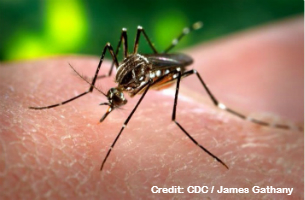 An outbreak of Zika is spreading through Central and South America, Mexico, and parts of the Caribbean, including U.S. territories. Though Zika currently isn't spreading on the mainland through mosquitoes—the main route of transmission of the virus—employers and workers should take steps to prevent or minimize the risk of Zika infection if transmission starts to occur or if they work with travelers returning to the U.S. with Zika. An OSHA and NIOSH interim guidance* provides recommendations on protecting workers who may be at risk for Zika virus infection through on-the-job exposure to mosquitoes or the blood or other body fluids of infected individuals. Visit OSHA's Zika webpage for more information.
An outbreak of Zika is spreading through Central and South America, Mexico, and parts of the Caribbean, including U.S. territories. Though Zika currently isn't spreading on the mainland through mosquitoes—the main route of transmission of the virus—employers and workers should take steps to prevent or minimize the risk of Zika infection if transmission starts to occur or if they work with travelers returning to the U.S. with Zika. An OSHA and NIOSH interim guidance* provides recommendations on protecting workers who may be at risk for Zika virus infection through on-the-job exposure to mosquitoes or the blood or other body fluids of infected individuals. Visit OSHA's Zika webpage for more information.Workers Memorial Day: Remembering and honoring those who've died on the job
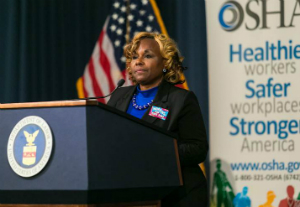 Every year more than 4,800 workers go to work and never return home as a result of entirely preventable workplace incidents and another 50,000 workers die from preventable work-related diseases. To remember and honor these workers, OSHA, unions, family members, workers and employers come together each year on April 28 to commemorate Workers Memorial Day.
Every year more than 4,800 workers go to work and never return home as a result of entirely preventable workplace incidents and another 50,000 workers die from preventable work-related diseases. To remember and honor these workers, OSHA, unions, family members, workers and employers come together each year on April 28 to commemorate Workers Memorial Day.
"Tomorrow and every day thereafter, in honor of those we have lost, we will fight to make sure that every American worker is protected against the myriad of hazards out there affecting their safety, their health, their lives and the security of their families," said OSHA Assistant Secretary Dr. David Michaels.
Workers Memorial Day was recognized by President Obama in a presidential proclamation issued April 28 and OSHA hosted an event marking the occasion at the U.S. Department of Labor headquarters in Washington, D.C. The program included remarks from Deputy Secretary Chris Lu, OSHA Assistant Secretary Dr. David Michaels, MSHA Assistant Secretary Joe Main, AFL-CIO Safety and Health Director Peg Seminario, United Steelworkers Safety and Health Director Mike Wright, and Duronda Pope from the United Steelworkers' Emergency Response Team.
This was just one of the many events commemorating Workers Memorial Day held across the country throughout the week, where participants rededicated themselves to the mission of preventing workplace injuries, illnesses, and deaths. To learn more, visit the Workers Memorial Day webpage.
CAOHC Approved Occupational Hearing Conservation Certification Course offering
 Register now to hold your seat in the June 1-3, 2016 “CAOHC Approved Occupational Hearing Conservation Certification Course” with CAOHC Course Director Timothy A. Swisher, MA, CCC-A.
Register now to hold your seat in the June 1-3, 2016 “CAOHC Approved Occupational Hearing Conservation Certification Course” with CAOHC Course Director Timothy A. Swisher, MA, CCC-A.
Subscribe to:
Comments (Atom)

